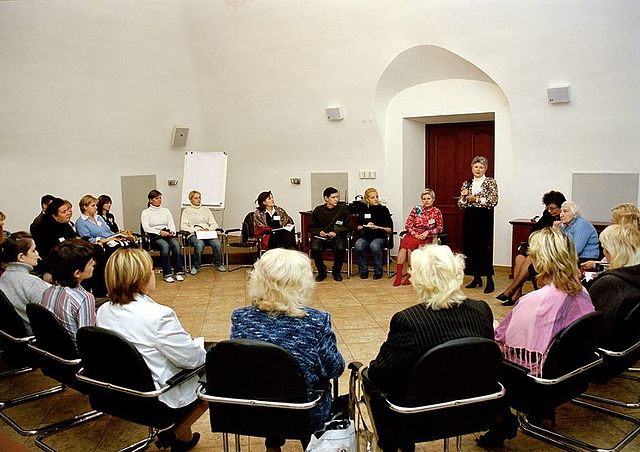“I’m afraid I won’t build someone’s trust in me.”
As of 2020, 58% of Americans resonated with this statement. The rationale behind this fear often stems from negative experiences in childhood and adolescence, such as growing up in an abusive household, enduring social rejection, low self-esteem, or being a child of divorced parents. According to the US Department of Health and Human Services, more than two-thirds of children reported experiencing at least one traumatic incident by the age of 16. The similarities between these two different percentages emphasize the research conducted by Very Well Mind, which concluded that distrust is a result of childhood trauma. Additional research suggests that “although both trust and distrust are strongly influenced by the individual’s unique environment, interestingly, trust shows significant genetic influences, whereas distrust does not. Rather, distrust appears to be primarily socialized, including influences within the family” (Stanford University).
The reasoning behind the fear of trust has been a phenomenon studied by developmental psychologists since the early 20th century. Erik Erikson developed the theory of trust vs mistrust, the first of eight stages aimed to “provide a framework for understanding an individual’s ability to trust” (PsychCrumbs). Essentially, this theory revealed that the most critical timeline in one’s perception of trust begins from birth and continues to approximately eighteen months of age. During this stage, “infants are uncertain about the world in which they live, and look towards their primary caregiver for stability and consistency of care” such as food, warmth, comfort, and security (Simply Psychology). Success in this stage emerges as a result of caregivers consistently providing for the infant’s individual needs, and therefore creating an environment where the infant learns the importance of reliability and support. Alternatively, distrust forms when these needs are neglected to be met, leading to the development of fear and the basic sense of mistrust in other relationships.
John Bowlby elaborates on Erikson’s findings through his explanation of the attachment theory and the four associated stages: secure, avoidant, ambivalent, and disorganized attachment.
Through his analysis of attachment styles, Bowlby revealed that “later relationships are likely to be a continuation of early attachment styles (secure and insecure) because the behavior of the infant’s primary attachment figure promotes an internal working model of relationships which leads the infant to expect the same in later relationships” (Simply Psychology). In other words, if one develops secure attachment as an infant, “an adaptive response to being abandoned, and the belief that one is worthy of love,” they will easily develop trust in other relationships.
There are many therapeutic methods designed to help increase one’s perception of trust, but it has been argued that group therapy is the most effective form of therapy to conquer this fear. Group therapy “provides more opportunity to exercise trust than individual therapy [as] it allows participants to interact with and develop relationships with multiple people” (Good Therapy). The activities utilized in group therapy are said to promote communication, trust, and personal growth.

A photo of individuals engaging in group therapy. Photo provided by: Wikimedia Commons.
No matter where you live, there is access to an elderly home. A 2022 survey conducted by Zippia revealed that there are 26,514 nursing homes in the United States; in New Orleans specifically, there are 27 nursing homes (US News).
Assisted living facilities and nursing homes can be ideal places for an individual to build trust as these communal environments provide a safe and supportive place for people to get to know each other and build relationships in a low risk setting. Programs at these facilities, specifically the card game, Bridge, foster an environment of trust and intimacy.
Assuming you are not a current resident of an old aging home, there are still many ways to get involved within this community. Due to the U.S. nursing home market size annual growth increase of 1.9% from 2017 to 2022, and the expected 4.5% growth rate in 2022, nursing homes are always looking for volunteers to “interact on a more social and friendly level with the residents” (Sunflower Communities). This is amplified by the fact that “federal law requires any hospice receiving financial support from Medicare or Medicaid to have at least 5 percent of the care provided to residents done through volunteer workers” (HowStuffWorks). Although each individual nursing home has their own process and requirements for volunteers, below is a general guide of how one can become involved.
The typical requirements for becoming a volunteer in a nursing home are quite simple: “you must love to be around older, frail people and you must be willing to take some direction from the staff members who know best how you can help” (Louisiana Nursing Home Association). Most nursing homes accept volunteers from “all walks of life. Whether you are a high school student or sorority or fraternity member needing to fulfill service hours or you are retired, a homemaker or a full-time professional just wanting to experience the joy of volunteering, we welcome you” (Louisiana Nursing Home Association). Once you have determined that you have met the requirements of the specific nursing home where you desire to volunteer, you must go through a formal application process. This involves:
After the necessary steps have been taken to be accepted as a volunteer, you are now ready to build trust through the game of Bridge. Yes, that’s right, Bridge.
Bridge is played with a standard 52 playing card deck and involves four players, divided into two teams of two people each. As the New York Times writes, “Bridge is a partnership game. Above all else, a successful bridge player must be a great partner. Trust, communication and patience are the essential attributes of winning at bridge. Once a strong partnership is formed, it provides a platform for individual creativity, allowing players to inject their own personalities into the game.” The game begins with each player seated facing their partner; the cards are then shuffled and placed on the table face down. Each player selects a card, and the individual who picks the highest card deals first. The objective for the game is for “each partnership to attempt to score points by making its bid, or by defeating the opposing partnership’s bid. At the end of play, the side with the most points wins” (Bicycle Cards). A bid “represents the number of tricks the team expects to make along with the trump suit they desire for the round. The minimum bid is 7 tricks, while the maximum is 13” (Playing Card Decks). In order to win the game, “a pair must win tricks which consist of four cards, one from each player’s hand, played in clockwise order” (Casino.org).
Bridge is often referred to as the most complex card game, so it may take some time before you feel confident in your ability to play. However, once you do, you will realize that “the Bridge card game offers a microcosm of interrelationships between people. Watching what happens at the table provides an opportunity of what happens between people in real life. Knowledge, skill, learning, communication, trust, compatibility, risk assessment and mitigation, as well as many other behavioral traits can be observed at the table” (Bridge Hands). This finding is emphasized through a 2014 research study conducted by Tor Vegata. In this study, Vegata revealed “that Bridge players, due to their superior team play habits, are more likely to adopt cooperative behavior” (World Bridge Federation). He explains that “Bridge is a “trust game,” where deception plays little to no role. Bridge players make more polarized choices and choose the maximum trust or contribution significantly more often” (World Bridge Federation). Generally speaking, “Playing board games triggers the release of endorphins, the body’s natural ‘feel-good’ chemicals. ‘Happy hormones’ have the power to improve conscious and unconscious mind functions, leaving a person feeling… content” and vulnerable, both emotions associated with trust (Bucks County Free Library).
The correlation between building trust through Bridge and nursing homes may seem random but Bridge is a game predominantly played in these facilities. The average age of a bridge player in the United States is 71 and the average nursing home resident is over the age of 65 (A Place For Mom). Playing this card game with a group of elders will build your trust as it encompasses the values and benefits of group therapy that were previously mentioned. You are committing to meeting with a group of people for a designated amount of time and sharing your emotions. The nursing home offers a low risk, yet high-reward status as the individuals who live here start as strangers and have no connection to your personal life. You are engaging in a communal environment that fosters the importance of trust and communication for mutual gain leading to lifelong friendships.

An example play from the card game, Bridge. Photo by: Wikimedia Commons
Want some help on overcoming the fear of building trust? Here are sources that can help.
This Ted Talk was given in 2018 by Frances Frei, a Harvard Business School professor. In this 15 minute clip, she explains what she believes to be the three components to building trust (authenticity, logic, empathy), as well as how to repair one’s trust after it has been broken.
This podcast episode was released in January of 2017 and features Dr. John Gottman, a psychologist with over 50 years of research on marital stability and divorce prediction. In this episode, he discusses the key to “building your trust metric.”
This is a podcast encompassing all of the topics related to trust: how to create accountability in your relationship, why trust is so hard to gain, and how to move forward in a healthy way that allows you to forgive your partner.
This is a free online course that is split into four modules. The second module is the most relevant to this topic as it explains how to increase trust by uncovering common goals, common enemies, and interdependence. This module aims to teach how to build trusting relationships to achieve cooperation and mutual satisfaction.
This podcast features Dr. Henry Cloud, an acclaimed leadership expert, psychologist, and best-selling author. In this episode, Dr. Henry Cloud summarizes the findings from his new book, The Anatomy of Trust.
Brendon Burchard, a 3-time New York Times bestselling author, a globally respected high performance coach, and one of the world’s most watched, followed, and quoted personal development trainers with over 10 million followers, explains the value of trust and shares strategies for building self-trust.
In this episode, Dr. Lisa Marie Bobby, a psychologist, certified life coach, and marriage and family therapist answers the question of how one is able to repair trust once it’s been broken. She outlines what she considers to be the five critical steps.
This podcast is created by Dr. Abby Medcalf, a psychologist. In this particular episode, she discusses the common fears that prevent people from being honest with each other and emphasizes the importance of empathy and vulnerability in building trust.
 NOLAbeings
Multimedia artist Claire Bangser created NOLAbeings as a portrait-based story project that marries...
NOLAbeings
Multimedia artist Claire Bangser created NOLAbeings as a portrait-based story project that marries...
 Data corner: Adobe Suite (create a PDF, social media graphic, presentation, edit a photo and video
Data corner is where you go to work with analytics and top tech skills. It takes on everything from PERL and SQL to Canva and Sprout Social.
Data corner: Adobe Suite (create a PDF, social media graphic, presentation, edit a photo and video
Data corner is where you go to work with analytics and top tech skills. It takes on everything from PERL and SQL to Canva and Sprout Social.

This blog is very great aarp united healthcare login